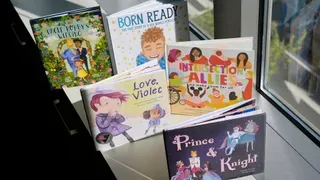July 25, 2016
Breaking Down the Gender Stereotype in Kids' Clothing
Anne D'Innocenzo READ TIME: 4 MIN.
Pink for girls. Truck motifs for boys. A growing number of parents want to get outside those parameters when it comes to dressing their kids.
Kristin Higgins was adamant about not pushing "girly" stereotypes on her daughter, and painted her room in shades of green. Higgins later dressed her up in superhero costumes. But as her daughter got older, it took more work to locate items that broke the mold. For "Star Wars"-themed pajamas, she had to go to the boys' section.
"It's hard to find gender-neutral clothing," said Higgins, 35, of Little Rock, whose daughter is now 6. "I want her to just get up and put on the clothing without thinking of putting on a costume, an identity."
Shopping for her 7-month-old son, Higgins finds clothes mainly have pictures like fire engines or sharks. What about cats, cupcakes or hearts, she wonders.
For parents looking for clothes that defy gender norms, the options for back-to-school shopping are still limited - but they're growing. Some big retailers like Lands' End and Zara are making small changes to their offerings, while some frustrated parents have launched their own companies to make the items they wanted to find.
"There is really a sharp divide between what is considered girls' stuff and what's considered boys' stuff," said Courtney Hartman. She started Seattle-based Jessy & Jack, a collection of unisex T-shirts for kids that have robots and dinosaurs, and Free to Be Kids, where a shirt with the slogan, "I'm a Cat Guy" comes in blue, gray and yellow.
Companies like Jessy & Jack and a collection called Princess Awesome, where dresses have trains and planes, are among nearly 20 online brands that formed a campaign called Clothes Without Limits last year that they're reprising for the back-to-school season. Still, many of the items are not cheap - T-shirts at $20 can be pricey for growing kids.
Bigger companies are offering some options, after similar shifts in the toy and bedding aisles to more neutral signs and products. Lands' End launched a line of science T-shirts two years ago after a customer complained on social media that there was only one version for boys. As part of its new Cat & Jack brand of children's clothing that kids helped design, Target offers unisex-fit T-shirts online with slogans like, "Smart & Strong" and "Future Astronaut."
And fast-fashion chain Zara launched a collection in March for teens and older called "Ungendered" under its TRF line, which focuses on basics like T-shirts, sweatshirts and jeans. Experts and parents also notice that some images like dinosaurs are popping up on girls' clothing under the Boden brand and others.
'Boys' Vs. 'Girls'
More has changed for girls' clothes than for boys, but the vast majority of children's clothing is still gender-specific, says Marshal Cohen, chief industry analyst at market research group NPD Group Inc.
Martine Zoer, who founded Seattle-based Quirkie Kids because her sons wanted to wear pink, said that in response to her selling unisex shirts in that hue, she says she got emails saying "boys should not wear pink as it would turn them gay."
A good portion of children's clothing buyers are grandparents who tend to embrace more traditional ideas, says Cohen, who doesn't expect large-scale change until the next generation starts having children.
"Once we get past the cultural discussion, that's when you'll see the (major) brands step out," Cohen said. "No one wants to risk the chance of rocking the boat."
Chris Guerin of Portland, Oregon, says teaching his mother-in-law to buy clothes that don't reinforce gender stereotypes is a work in progress.
"When she goes shopping with Nana, she comes back with princess (outfits) and tiaras," Guerin says of his 3-year-old daughter. "We don't care for that. But it's hard to bring up the issue."
The differences crystallized in the late 1980s, according to Jo B. Paoletti, a professor of American Studies at the University of Maryland and author of "Pink and Blue: Telling the Girls from the Boys in America." Paoletti noticed it when buying clothing for her daughter, who was born in 1982, and her son, four years later. By the mid-1990s, "pink-washing was widespread," she said. Even disposable diapers came in blue and pink.
In part, manufacturers and marketers wanted to boost sales to American couples having fewer kids, Paoletti said. She also reasoned that parents were rebelling against the more unisex fashions like corduroy pants they grew up with. But Paoletti said the change is harmful.
"It encourages very young children - as young as 2 - to judge and interact with others in highly stereotyped ways," she said. "We know, based on nearly 50 years of social science research, that stereotyped thinking hurts all of us, whether we are dealing with racial, gender, or any other form of stereotype."
Macy's says kids' clothes are generally separated into boys' and girls' sections, but with an array of colors and styles in each. "A lot of kids' apparel today is active - sweatpants and sweatshirts, graphic Ts, etc. - and are inherently unisex," spokeswoman Holly Thomas said in an email.
Stores like J.C. Penney and Nordstrom say they listen to shoppers, but aren't getting customer requests to blur the gender lines.
Those behind the new brands say they're seeing the demand. Hartman said annual sales are pushing six-digit figures.
Higgins recalled that when her daughter was in day care, she came home crying because some boys made fun of her navy blue sneakers, calling them "boy shoes." She often puts together kid outfits from thrift shops, and as she thumbs through the racks reminds her daughter: "There are no boy colors. There are no girl colors."







